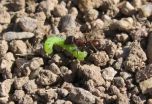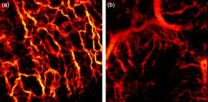(Press-News.org) Researchers at the Sahlgrenska Academy, University of Gothenburg, Sweden, have identified a molecule in the immune system that could affect hunger and satiety. The researchers hope that new treatments for obesity will benefit from this finding.
Interleukin-6 is a chemical messenger in our immune system that plays an important role in fighting off infection. However, recent research has, surprisingly, shown that it can also trigger weight loss. Researchers at Sahlgrenska Academy, University of Gothenburg, have been investigating and managed to identify the specific types of brain cells that are targeted by the interleukin-6 molecule.
The results show that the cells that are affected by interleukin-6 produce substances that not only affect our sense of hunger and fullness but also control the body's ability to burn fat. "Interleukin-6 increases levels of substances in the brain that trigger weight loss, which could explain why high levels of this molecule lead to weight loss," says doctoral student Erik Schéle, who is presenting the results in his thesis.
It is known that our normally low levels of interleukin-6 in the brain increase dramatically during an infection, typically accompanied by reduced hunger and fatigue.
"Our previous findings would indicate that interleukin-6 can play a key role in regulating the metabolism of healthy individuals too," says Erik Schéle.
"This is clearly substantiated by our finding that mice which lack interleukin-6 get fat, and that the metabolism of rats injected with interleukin-6 directly into the brain increases."
Although it is not yet fully understood how interleukin-6 in the brain affects bodyweight, the researchers have concluded that anyone whose brain produces plenty of interleukin-6 could be protected against overweight. The thesis also shows that our gut bacteria indirectly affect the substances in the brain that regulate bodyweight.
"This is both surprising and new. It could in the long run lead to people fighting obesity by changing what they eat in line with how it affects the brain," says Erik Schéle.
###Contact;
Erik Schéle, Sahlgrenska Academy, University of Gothenburg.
+ 46 31 786 3681
erik.schele@medic.gu.se
Immune system molecule affects our weight
2012-09-24
ELSE PRESS RELEASES FROM THIS DATE:
New back pain gene identified in largest genetic study of its kind
2012-09-24
Researchers at King's College London have for the first time identified a gene linked to age-related degeneration of the intervertebral discs in the spine, a common cause of lower back pain.
Costing the UK an estimated £7billion a year due to sickness leave and treatment costs, the causes of back pain are not yet fully understood. Until now, the genetic cause of lower back pain associated with lumbar disc degeneration (LDD) was unknown, but the largest study to date, published this week in the journal Annals of Rheumatic Diseases, has revealed an association with the ...
Red king or red queen
2012-09-24
This press release is available in German.
The relationship between species determines how rapidly they evolve. Parasites and their hosts coevolve more rapidly, and partners in a mutualistic relationship can evolve more slowly. But this view is obviously too simplistic. The rate of evolution in a mutualistic relationship does not depend only on the type of interactions, but also on the number of individuals involved, according to a model developed by researchers of the Max Planck Institute for Evolutionary Biology in Plön, Germany. Therefore, while partners can benefit ...
Two-thirds of the world's new solar panels were installed in Europe in 2011
2012-09-24
Europe accounted for two thirds of the world-wide newly installed photovoltaic (PV) capacity in 2011, with 18.5 GW. Its overall PV capacity totalled 52 GW. The yearly electricity produced by PV could power a country with the electricity demand of Austria, which corresponds to 2% of the EU's electricity needs. These are some of the highlights of the 2012 Photovoltaics Status Report published today by the European Commission's Joint Research Centre.
The study summarises and evaluates the current activities regarding manufacturing, policies and market implementation world-wide. ...
Glacial youth therapy for the Scandinavian landscape
2012-09-24
The high elevation flat surfaces characteristic of the Norwegian landscape are in geologically terms young, according to a paper in Nature Geoscience.
In a paper recently published in Nature Geoscience, researchers from the University of Bergen (UiB) and ETH Zurich have demonstrated that ice sheets have extensively shaped the fjords of Norway for the last 2.8 million years.
– However, the massive sediment record deposited offshore Norway during this period tells us a more complex story, explains Postdoctoral Fellow Philippe Steer at UiB's Department of Earth Science ...
Fueling the fleet, Navy looks to the seas
2012-09-24
WASHINGTON--Refueling U.S. Navy vessels, at sea and underway, is a costly endeavor in terms of logistics, time, fiscal constraints and threats to national security and sailors at sea.
In Fiscal Year 2011, the U.S. Navy Military Sea Lift Command, the primary supplier of fuel and oil to the U.S. Navy fleet, delivered nearly 600 million gallons of fuel to Navy vessels underway, operating 15 fleet replenishment oilers around the globe.
From Seawater to CO2
Scientists at the U.S. Naval Research Laboratory are developing a process to extract carbon dioxide (CO2) and produce ...
Glass half full: Double-strength glass may be within reach
2012-09-24
Glass is strong enough for so much: windshields, buildings and many other things that need to handle high stress without breaking. But scientists wholook at the structure of glass strictly by the numbers believe some of the latest methods from the microelectronics and nanotechnology industry could produceglass that's about twice as strong as the best available today.
Rice University chemist Peter Wolynes is one of them. Wolynes and Rice graduate student Apiwat Wisitsorasak determined in a new study that a process called chemical vapor deposition, which is used industrially ...
Researchers demonstrate cheaper way to produce NFO thin films
2012-09-24
Researchers from North Carolina State University and the Georgia Institute of Technology have demonstrated a less-expensive way to create textured nickel ferrite (NFO) ceramic thin films, which can easily be scaled up to address manufacturing needs. NFO is a magnetic material that holds promise for microwave technologies and next-generation memory devices.
Specifically, this is the first time researchers have used a chemical deposition process to create NFO thin films that are "textured" – meaning they have an aligned crystalline structure. Arraying the crystalline structure ...
3-year, 676-child trial shows effectiveness of low-cost intervention to improve sun protection
2012-09-24
A blistering sunburn during childhood or adolescence more than doubles the adult risk of skin cancer. The accumulation of long-term sun exposure may be equally dangerous. A study from the Colorado School of Public Health and the University of Colorado Cancer Center recently published in the American Journal of Preventive Medicine shows one way to reduce this exposure: a double-blind randomized clinical trial of mailed sun protection packets led to higher frequency of sun protective behaviors including the use of long clothing, hats, shade, sunscreen, and midday sun avoidance.
"This ...
EARTH: Bakken boom and the new Wild West
2012-09-24
Alexandria, VA – Diesel-soaked clothing, 90-hour work weeks, and the constant groaning of a multimillion-dollar oil rig towering overhead: Welcome to life in Williston, N.D., home of the United States' latest oil boom. In this month's issue of EARTH Magazine, R. Tyler Powers, a young geologist thrust into the middle of the new boomtown, offers his perspective on what life is like today in the new Wild West.
Thousands of oil rigs sit atop the Bakken Formation, a Late Devonian to Early Mississippian rock formation that underlies parts of Montana, North Dakota, Saskatchewan ...
Tissues tell the tale: Non-invasive optical technique detects cancer by looking under the skin
2012-09-24
VIDEO:
This is a 2x2x2mm extracted blood vessel structure of basal cell carcinoma in vivo exhibiting a chaotic vascular pattern (left). Virtually cut volume obtained with OCT displaying the embedded blood...
Click here for more information.
WASHINGTON, Sept. 24, 2012—The trained eye of a dermatologist can identify many types of skin lesions, but human sight only goes so far. Now an international team of researchers has developed an advanced optics system to noninvasively ...

